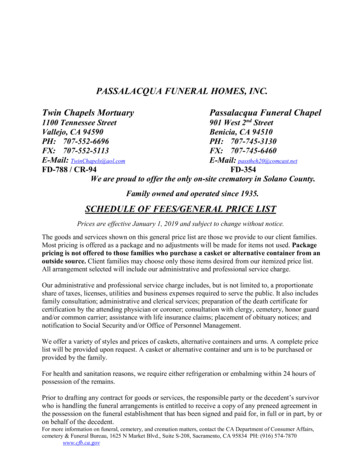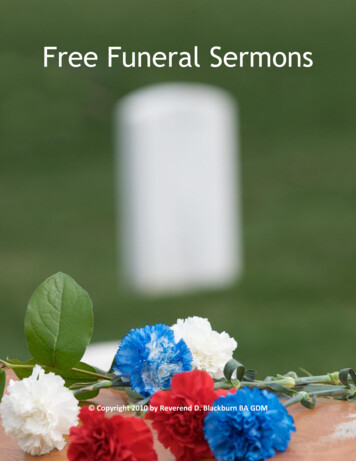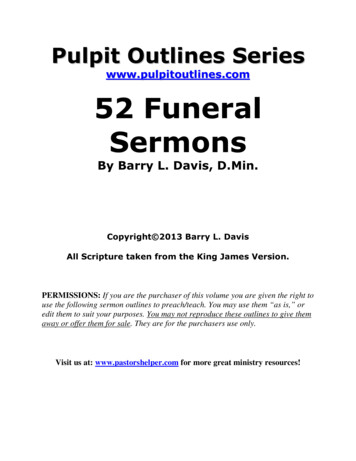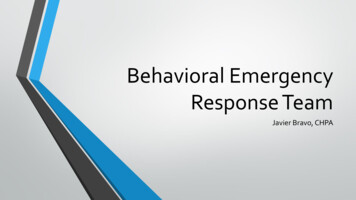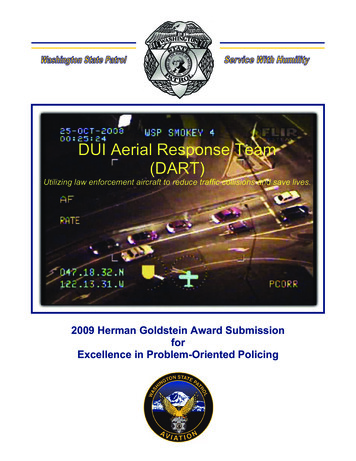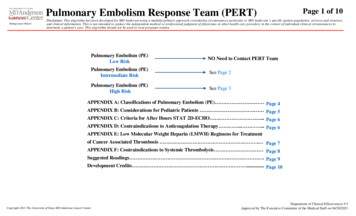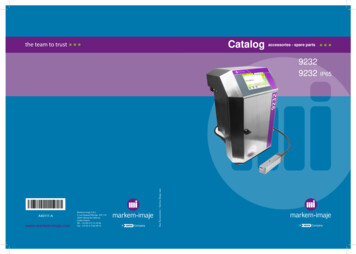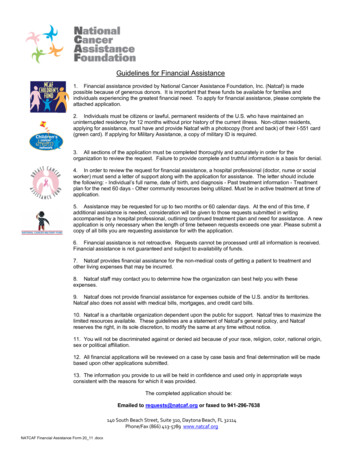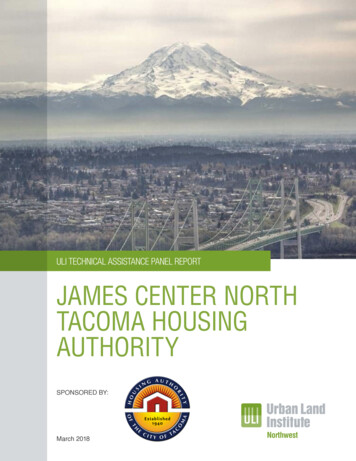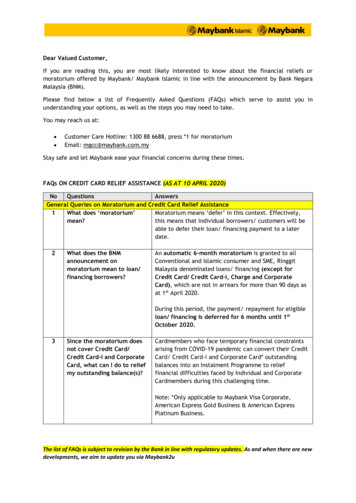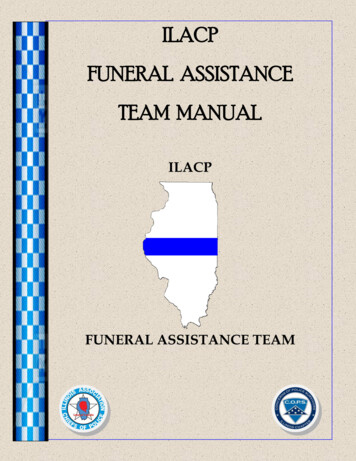
Transcription
ILACPFUNERAL ASSISTANCETEAM MANUALILACPFUNERAL ASSISTANCE TEAM
MISSION STATEMENTThe mission of the ILACP Funeral Assistance Team is to provide supportand assistance to a stricken agency and to the survivors of the fallen lawenforcement personnel.2
Board of Directors and Team Members - - - - - - - - - - - - - - - - - - - - 4History - - - - - - - - - - - - - - - - - - - - -- - - - - - - - - - - - - - - - - - - - - - --6Selection of Team Members - - - - - - - - - - - - - - - - - - - - - -- - - - - -8Activation of the Team / Team Response - - - - - - - - - - - - - - - - - - -10Line of Duty Death (LODD) Protocol - - - - - - - - - - - - - - - - - - - - -12Off-Duty Death Protocol - - - - - - - - - - - - - - - - - - - - - - - - - - - - - -30Retired Death Protocol - - - - - - - - - - - - - - - - - - - - - - - - - - - - - - - -44Police Canine Death Protocol - - - - - - - - - - - - - - - - - - - - - - - - - - - - 66Critical Incident Stress Management (CISM) - - - - - - - - - - - - - - - - 74Resource Guide - - - - - - - - - -- - - - - - - - - -- - - - - - - - - - - - - - - - - - - 76Checklist - - - - - - - - - - - - - - - - - - - - -- - - - - - - - - - - - - - - - - - - - - - -- 783
Chapter1Board of Directors and Team MembersChairperson:John J. Konopek, Jr.Chief of Police, Plainfield Police DepartmentCo-Chairperson:Steve NeubauerChief of Police, Tinley Park Police DepartmentTeam Member:Mark PeytonMajor of Police, Illinois State PoliceTeam Member:Anthony NovakCommander of Police, Plainfield Police DepartmentTeam Member:Eric MunsonSergeant of Police, Plainfield Police DepartmentTeam Member:Tracy CaliendoOfficer, Plainfield Police DepartmentTeam Member:Joe MaranowiczDeputy Chief of Police, Addison Police DepartmentTeam Member:Mark KarczewskiCaptain of Police, Illinois State PoliceTeam Member:Mark HannanAuxiliary Officer, Wheaton Police Department4
Team Member:Tom HoganOfficer, Woodridge Police DepartmentTeam Member:Matt RiedelSergeant of Police, Hanover Park Police DepartmentTeam Member:William WeilSergeant of Police, Hanover Park Police DepartmentTeam Member:Doug JacobsSergeant of Police, Oak Brook Police DepartmentTeam Member:Paul LichamerSergeant of Police, Downers Grove Police DepartmentTeam Member:Daniel WattonLieutenant of Police, Rockford Police DepartmentTeam Member:Patrick St. JohnSergeant, Tinley Park Police DepartmentTeam Member:Perry DubishOfficer, Tinley Park Police Department5
Chapter2HistoryIn December of 2013, John Konopek, Police Chief of the Plainfield PoliceDepartment, approached the Board Members of the Illinois Association ofChiefs of Police (ILACP) and sought their permission and support for theconcept of creating a special committee to create a standardized protocol forfuneral services of law enforcement personnel. The funeral protocolswould be separated into the following categories, which will be laterdescribed in greater detail: Line of Duty Death, Off-Duty Death, RetiredDeath, and Police Canine Death. The ILACP fully supported the conceptand as a result a committee was formed.Chief Konopek, along with Steve Neubauer, Chief of the Tinley Park PoliceDepartment, became the leaders of the committee.On Tuesday, March 4th, 2014, the committee, which consisted of severalindividuals, sworn and non-sworn, throughout the State of Illinois, as wellas the State of Indiana, met and began to work collectively towardaccomplishing the task given to the committee. It was because of the hardwork and dedication of the group that created the documentation set forth inthis manual.6
A special amount of gratitude is given to several members of the IllinoisChapter of Concerns of Police Survivors, along with several members of theIndiana Fraternal Order of Police Critical Incident/Memorial Team, whoprovided a valuable amount of guidance and became part of the committee.Their input and assistance helped facilitate these protocols.7
Chapter3Selection of Team MembersIndividuals expressing interest in becoming a team member of the ILACPFuneral Assistance Team are required to submit an application, along with aletter of approval from their department head (i.e. Chief, Sheriff, Director,etc.) supporting their involvement and commitment to the team.Team members and department heads must understand that team membersmust be able to respond for up to seven (7) calendar days and be willing towork long hours each day to fulfill the duties and responsibilities of theTeam. Team members will also be expected to provide a vehicle for theduration of the activation.Those members of the team activated, will be reimbursed for the followingexpenses: Mileage Lodging Per DiemTeam members will not be reimbursed for: Salary8
9
Chapter4Activation of the Team / Team ResponseUpon request from a department head of an agency seeking the assistance ofthe ILACP Funeral Assistance Team, team members will receive a group textseeking their assistance and commitment to assist in the planning andpreparation of the funeral detail.The group text will be set up through the Western Will CountyCommunication Center (WESCOM) utilizing a “Everbridge” paging system.Team members receiving the text will respond accordingly with theiravailability and thus begin the activation of the team. They will also benotified of the “Officer-in-Charge” of the detail assignment, when, and whereto respond.In addition, ILEAS will also have the appropriate contact informationavailable to provide to agencies seeking the assistance of the ILACP FuneralAssistance Team or for additional information. The direct line has beenestablished through WESCOM, which is (815) 782-6782.Protocols have been established with WESCOM identifying the appropriatequestions to ask as well as the names and contact information for those teammembers responsible for facilitating the activation of the team.10
11
Chapter5Line of Duty Death (LODD) ProtocolPurpose:This is a guide to Law Enforcement Officers Active Duty General Protocols.Law Enforcement is a Quasi-Military function which may involve the suddendeath of a Peace Officer, who took an Oath to uphold the guidelines of Federal,State and Local Ordinances. These guidelines are established through acombination of Law Enforcement Agencies and Military Protocol. Adherenceto these guidelines is not mandatory, and should be utilized as a tool to assistyour agency with the policies and procedures of performing an Active DutyFuneral.Policy:It is the policy of this Association to provide assistance to the immediatesurvivors of an employee who dies in the line-of-duty, whether feloniously oraccidentally, while an active member of the Office to include the clarificationand comprehensive study of survivor benefits, and to provide tangible andintangible emotional support during this traumatic period of re-adjustment forthe surviving family.** If the death was a result of a suicide, consultation between the Agency andthe deceased’s family should be held. Although each instance should betreated individually (case-by-case), and the circumstances investigated,generally, unless the Suicide was a result of an action by the deceased thatbrought discredit to themselves or the Agency, the appropriate funeralprotocols should be afforded and allowed.12
Definitions:Line-of-Duty Death: The death of an active duty Law Enforcement OfficerDeputy by felonious or accidental means during the course of performingpolice functions while on or off-duty.Line-of-Duty Injury or Illness: For the purposes of this policy a line-of-dutyinjury or illness shall be an injury or systemic illness serious enough forhospitalization; or time away from the office is ordered by a physician for anindefinite period.Survivor: For the purposes of this policy the term Survivor will apply first tothe immediate family members of the deceased agency member. The survivingspouse will be the decision maker regarding arrangements, and the personfrom whom the Family Liaison Representative will take direction. Should anOffice member be single, the Family Liaison Representative will work directlywith the surviving parents and adult children, if any.Survivors: Primary family members of the injured or deceased Officer/Deputy, including spouse, children, grandchildren, parents, grandparents,siblings, fiancé, and/or significant others.Beneficiary: Those designated by the Officer/Deputy as recipients of specificdeath benefits.Benefits: Financial payments made to the family to assist with financialstability following the loss of a loved one.Funeral Payments: Financial payments made to the surviving families of aSworn Law Enforcement Officer/Deputy killed in the line-of-duty which arespecifically earmarked for funeral payments.Notification Team: These individuals will be responsible for making properin-person notification to the survivor(s) in the event of a death or seriousinjury of a Department member. This team should consist of the Chief ofPolice/Sheriff or designee, the Officer’s/Deputy’s Commanding Officer, and/or the pre-selected persons of the Officer’s/Deputy’s choice as requested anddocumented in the Confidential Line of Duty Death Information Form. Ifavailable, the Office chaplain or the employee’s pastor (if noted in the Officeforms).13
Family Liaison Officer: The primary facilitator between the family and theDepartment. This individual is designated by the Chief of Police or Sheriff.The FLO has the responsibility of attending to the needs of the family. TheFLO has the responsibility of making the family aware of the support andservices that the agency can offer. The FLO shall be available to the family ona 24-hour basis throughout the entire process. This position will be thecoordinating point for planning and follow-up care for the family. Thisposition ensures the expedient accomplishments of tasks in support of thefamily and the funeral process. This member should be a person who knewthe deceased Officer/Deputy, and should not be a member who is emotionallyinvolved in the death; as to render him/her ineffective. This position is not adecision making position, but is that of a facilitator between the family and theDepartment/Office. The Family Liaison Officer should work closely andprovide all information to the OIC in an Active Duty Officer’s death.An additional FLO should be considered for children that do not reside withthe fallen officer.Office/Department Liaison Officer: This individual must be command levelwith the authority to allow the Family Liaison Officer to make financialobligations and purchases. The Office/Department Liaison Officer shall betasked with securing the services of the Northern Illinois Critical IncidentStress Management Team. The Office/Department Liaison Officer will keep allOffice/Department personnel up to date on the plans and arrangements asthey receive that information from the Family Liaison Officer. The OfficeLiaison Officer is the contact for any media representatives who may contactthe Office/Department for information regarding the injury or death. Mediareleases, reports, etc., which are to be released regarding the death of anypersonnel shall be provided to the family of the employee prior to when theyare released to the public. Additionally, absolutely no information regardingthe death of an employee shall be released prior to the deceased personnel’sfamily being notified.Funeral Liaison Officer: This individual will be responsible for assisting thefamily with the wake and funeral arrangements for the deceased Office/Department member. The Funeral Liaison Officer will meet with familymembers to brief them on the procedures involved in a law enforcementfuneral, however they will ensure all the needs and wishes of the family comebefore those of the Office. The Funeral Liaison Officer will also be responsiblefor logistical issues such as determining needs for travel arrangements for out14
of town family members as well as any special needs of the family during thefuneral and reporting this information to the Office Liaison Officer. TheFuneral Liaison Officer will also coordinate Office/Department participationalong with all other law enforcement participation in the wake and funeralsuch as parking, seating arrangements, motorcades, and Honor Guardparticipation. The Funeral Liaison Officer will work closely with all otherOffice/Department representatives to ensure everything is prepared to showthe deceased member and their survivors the proper respect.Honor Guard Representative: This individual will be responsible forcoordinating all Honor Guard participation for the appropriate services of thedeceased employee. This will include requesting outside assistance from otheragency honor guards, pipe and drum corps, buglers, law enforcement walkthrough, flag folding/presentation, etc. The Honor Guard Representativeshould be the either the Honor Guard Commander or Assistant Commander ifthe Honor Guard Commander is unavailable. The Honor Guard Coordinatorwill work closely with the Family Liaison Officer and Funeral Liaison Officerto ensure the family wishes are carried out exactly as requested. The HonorGuard Representative will be responsible for coordinating the logistics at thefuneral home and working directly with the Funeral Home Director. TheHonor Guard Representative will be responsible for coordinating the logisticsat the grave side service, if applicable, with cemetery personnel.Benefits Officer: This individual is responsible for compiling all death benefitsdue to the survivors. These benefits will be maintained in a handbook that willbe reviewed and updated on an annual basis. The Benefits Officer will work inconjunction with the command staff to assemble this information as soon aspossible upon the death of a member and coordinate with the Family LiaisonOfficer to provide this information to the survivors. The Benefits Officer willalso prepare and file the necessary paperwork for these benefits on behalf ofthe family, as well as check the status of claims until the benefits are paid tothe survivor.Hospital Liaison Officer: A Supervisor or Officer who has been assigned toact as the liaison between the hospital and the Office/Department. TheHospital Liaison Officer will be responsible for coordinating the activities ofhospital personnel, the member’s family, fellow Police Officer’s, the press, andany other that may be involved15
Traffic Coordinator: A member of the Command Staff that will work closelywith the Funeral Liaison Officer for all traffic related issues including but notlimited to the funeral procession route, barricades, parking at the funeral, andparking at the cemetery. This individual may also need to coordinate EMS,tow trucks and port-a-lets along the procession route.Formations and Movements Officer(s): An individual(s) appointed by theChief of Police/Sheriff or designee who is responsible for all formations andprocessional routes. This individual plans and lines up the formations, andmay make commands and instruct formations. The Formation and MovementOfficer(s) need to have knowledge of, and work directly with, the TrafficCoordinator as to not obstruct the pre-determined routes. Formation andMovement Officer(s) may also need to coordinate with obtaining port-a-lets,viewing screens, water stations, heat stations and public address systems.Officer In Charge: An individual(s) appointed by the Chief of Police/Sheriffor designee who is responsible for the overall operation of the entire event.The Officer In Charge shall ensure that all protocols are being followed byrepresentatives and officers involved in the planning and operations of theevent. In addition the Officer In Charge shall resolve any conflicts that mayarise during the planning and execution phases of the event.The following positions must be activated immediately upon a death orserious injury of an Office/Department member. While each of these is outlined individually, it is also recognized that several positions may becombined and assigned to one person. Each individual assuming a functionalresponsibility will be responsible for maintaining resources and informationfor their function and have those resources readily available.Notification Team:Family Liaison RepresentativeOffice Liaison RepresentativeFuneral Liaison RepresentativeHonor Guard RepresentativeBenefits OfficerOfficer In Charge16
Notification of DeathImmediately upon a serious injury or death the Family Liaison Representativewill be notified so that they can retrieve the Office member’s emergencyinformation and contact the Notification Team. The on duty Watch Commanderwill immediately take possession of the deceased member’s badge, commissioncard and, any Office/Department issued weapons. The badge will be processedand returned to the family after the deceased final arrangements have beenconcluded.The name of the deceased employee will never be released to the media beforeimmediate survivors living in the area are notified. The name of the involvedemployee shall never be transmitted over the radio system. Personnel should beordered not to disseminate any information over social media outlets.Notification will always be made in person and will never be made alone. TheNotification Team will act as the informing representatives and should all bepresent unless circumstances necessitate otherwise.If the Notification Team is not readily accessible, notification should not bedelayed until these personnel can assemble. If the Office member has not yetdied, all attempts will be made to get the family to the hospital prior to themember’s death.When most public safety families see an agency representative at the home orplace of work, they will know something is wrong. Ask to be admitted to thehome or place of work. Never make a death notification on the doorstep. Gathereveryone in the home and ask them to sit down. Inform them slowly and clearlyof the information you have on the incident. Make sure you use the employee’sfirst name during the notification.If the employee has already died, relay that information. Never give the family afalse sense of hope. Use words like “dead” and “died” rather than “gone away”or “passed away”. If the family wants to go to the hospital, they should betransported via non-marked Office vehicle. It is highly recommended that thefamily not drive themselves to the hospital. Should there be serious resistance,and the family insists on driving, have an Officer/Deputy accompany them in thecar.17
The Office/Department should find out if there are any young children in thehome. Notification representatives will be responsible for arrangingimmediate baby-sitting needs. Because of the nature of possible radiotransmissions, the Officer/Deputy transporting the family should notify theOffice/Department personnel or Hospital Liaison Officer at the hospital byphone that the family is en-route. Surviving parents will also be afforded thecourtesy of personal notification if they live in the same geographic area. If theemployee was married, notification will be at the request of the deceasedemployee’s spouse. In this case, the parents’ Notification Team will be anOffice/Department representative designated by the Chief of Police/Sheriffand another department employee who knows the family well. If immediatesurvivors live out of town, request personal death notification from the publicsafety agency in that area. Logistical arrangements should enablesimultaneous telephone contact with the Office/Department.Assisting the Family at the Hospital:The Family Liaison Officer will be responsible for acting as the liaison forinformation between the hospital staff and the family. Additional informationregarding the member’s condition will be transmitted from the Family LiaisonOfficer to the Office/Department Liaison Officer for release to the rest of theagency.The family of the Officer/Deputy will be afforded the opportunity to see theOfficer/Deputy as soon as they w
Auxiliary Officer, Wheaton Police Department . releases, reports, etc., which are to be released regarding the death of any personnel shall be provided to the family of the employee prior to when they are released to the
